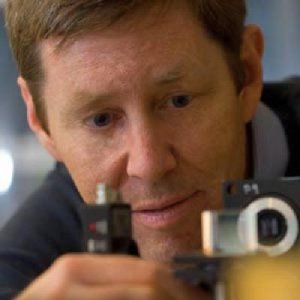Sep 23 2009
A Rice University-led team of physicists at seven U.S. universities has won $5 million from the Department of Defense to build a simulator capable of tackling high-temperature superconductivity, one of the most vexing mysteries of modern physics.
 This is Rice University physicist Randy Hulet. Credit: Jeff Fitlow/Rice University
This is Rice University physicist Randy Hulet. Credit: Jeff Fitlow/Rice University
"The object is to simulate complex materials like high-temperature superconductors using ultracold atoms in an optical lattice," said Rice's Randy Hulet, the principal investigator on the project. "The lattice, which is created with lasers, simulates the crystal structure of the materials, while the atoms are stand-ins for the electrons."
The three-year grant was awarded today by the Army Research Office with funding from the Defense Advanced Research Projects Agency (DARPA). It is the second phase of funding awarded under DARPA's Optical Lattice Emulator (OLE) program. In the first phase of the program, Hulet's team and others showed it was possible to use ultracold atoms and lasers to build the type of structures needed to simulate high-temperature superconductors and other exotic materials.
Hulet's team includes co-prinicipal investigators Han Pu, also of Rice; Carlos Bolech of the University of Cincinnati; Jason Ho and Nandini Trivedi, both of Ohio State University; David Ceperley and Brian DeMarco, both of the University of Illinois, Urbana-Champaign; David Huse of Princeton University; Erich Mueller of Cornell University; and Vincent Liu of the University of Pittsburgh.
Superconductors are materials that convey electricity freely, without any resistance. Resistance is what causes wires to heat up as electricity moves through them, and resistance results in billions of dollars worth of losses annually in the U.S. power grid.
Superconductivity typically happens only at extremely cold temperatures, but in 1986 scientists discovered that some crystalline materials become superconductors at relatively high temperatures. Superconductivity in these materials, referred to as the cuprate superconductors, was found to occur along the two-dimensional planes that form their crystalline structure. Physicists still don't understand how superconductivity emerges in the cuprates, partly because of the inherent complexity of the real materials and partly because of the inevitable impurities and defects present in actual samples.
"Many physicists believe that a certain model called the Hubbard model can explain how the electrons in these materials attract one another, but it remains controversial," said Hulet. "Even though the model is simplified, solving it is an exponentially complex problem. It cannot be done on even the fastest computers."
The beauty of the OLE program comes in using ultracold atoms as proxies for electrons. Prior research in Hulet's lab and others has shown that at cold enough temperatures, the behavior of atoms is dictated by the same quantum mechanical rules that govern the behavior of electrons.
The other technological piece of the simulator -- the "optical lattice" -- is created using several laser beams. The light from one beam can interact with and cancel out light from other beams in a regular pattern. Using several lasers, the researchers can use this effect to create two- and three-dimensional light patterns that mimic the lattice-like atomic structure of crystals.
"It's difficult to study superconductivity in real materials, partly because even minor defects in the crystal structure can throw off the experimental results," Hulet said. "But with the optical lattice, we can know, with absolute certainty, that there are no defects. We can really probe the essence of the model."
Currently, Hulet's team is conducting two experiments that continue the proof-of-concept work the team completed in the first phase of DARPA's OLE program. In one of these experiments, Hulet's group is simulating a three-dimensional version of the Hubbard model. In another, they are probing the properties of atoms confined to one-dimensional tubes of light.
Ultimately, Hulet and his group hope to build a two-dimensional Hubbard model that mimics the structure of the cuprate superconductors. That may sound like a simpler task than building the 3D model, but Hulet said the technical challenges are greater in 2D. For instance, it requires his team to chill their atoms to temperatures that are colder than any yet achieved.
"The theoretical difficulty lies in the fact that the Hubbard model cannot be solved analytically and our classical computers are extremely inefficient in simulating it," said Rice physicist Han Pu, a theorist and co-principal investigator on the project. "To tackle this problem, we need new tools, and OLE is such a tool. An OLE is essentially a quantum computer that simulates the Hubbard model in lab. The findings will tell us the properties of the Hubbard model and give us crucial new insights into high-temperature superconductivity."